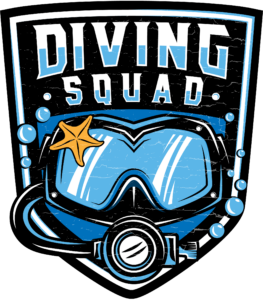
Best Travel Regulator of 2024: Diving Squad Reviews
(This is a sub article from our Main Page of the Best Scuba Diving Regulators).
When it comes to picking the best travel regulator – one that’s reliable and high quality, yet compact and lightweight; there’s many options on the market today.
Which is the best travel regulator for you, will depend on your budget, level of diving experience and how often you’ll be using it – among other factors!
Luckily, you can save yourself countless hours of research by reading our brutally honest reviews of the very best travel regulators currently available.
We’ve compared stats, highlighted pros, exposed cons and given each model a special reward for what we think suits it best.
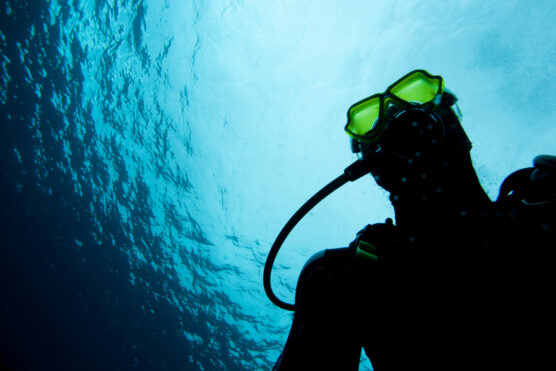
Quick Answer:
- Best Overall – Atomic Aquatics T3
- Cheapest – Mares Prestige 15X
- Best All Rounder – Oceanic Zeo FDXI
- Top Seller – Scubapro MK21
- Alternative Option – Hollis 500SE/DC7
Reviews of Best Travel Regulators
1) Best Travel Regulator: Atomic Aquatics T3
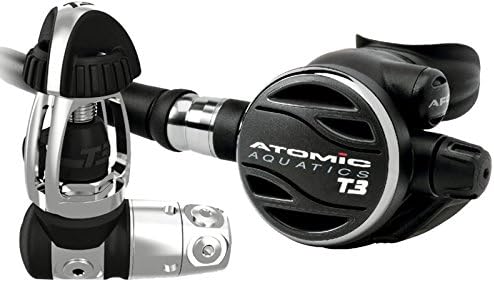
Let’s get the only downside of the Atomic Aquatic T3 out of the way first – it’s insanely expensive.
If you’re on a tight budget, you can jump to our review of the Mares Prestige 15X (which is over six times cheaper!), or if you’re after an excellent all-rounder travel regulator that’s only mid-priced, consider reading about the Oceanic Zeo FDXI.
However, if you have serious cash to splash and you’re after the absolute best quality travel regulator that money can buy… keep reading.
The Atomic Aquatics T3 is branded as the lightest scuba diving regulator in the world and weighs just 0.8kg (1.8lbs). One of the reasons it’s so light is because it’s made from high quality titanium which also makes it corrosion resistant and virtually indestructible.
The first stage has a minimalist and ergonomic sculpt, with a sleek Yoke connection. It utilises Atomics exclusive balanced Jet Sea high-flow piston, being equipped with 2 high pressure and 5 low pressure ports on a swivel turret. It’s worth noting that this is the only travel regulator to have 5 low pressure ports; other models have only 4 or less.
As for the second stage part, it features Atomic Comfort Swivel which allows 30 degree rotational movement without the hose kinking as well as a patented automatic flow level. It also features a Venturi system that adjusts itself as you go deeper underwater. There is also a user adjustable inhalation knob in case you need to detune the regulator.
The Atomic Aquatics T3 is “overbalanced”, which is a feature replacing the previous “balanced” trait, in high end regulators. In short it allows even easier breathing, when diving at depth and/or low on air. (To find out about terms such “balanced’ and “overbalanced”, ‘ check out the scuba regulator terminology section below!).
Finally, unlike most other regulators, you don’t need to take the Atomic Aquatics T3 for service each year because it has a 3 year 300 dives service interval!
In terms of overall quality, features and usability the Atomic Aquatics T3 is the hands down best travel regulator that money can buy. Yes, it’s pretty damn pricey but you’ll know where your money is going and it’ll make diving more noticeably comfortable and seamless than before whilst lasting a lifetime.
PROS:
- Lightest Option! Weighs 0.8kg (1.8lbs)
- Titanium Build = Highly Durable
- Sealed First Stages = Suitable for Cold Water Diving
- Second stage features Atomic Comfort Swivel
- Venturi System
- Service Interval of 3 years!
- Overbalanced for easier breathing
- 5 Low Pressure Ports
CONS:
- Very Expensive – two thousand dollars!
2) Cheapest Travel Regulator: Mares Prestige 15X
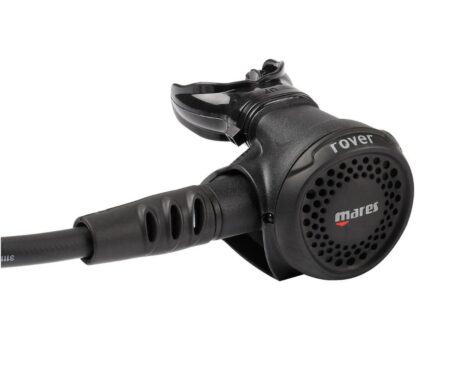
You will not find a cheaper (yet still good) travel regulator than this one, period. Yet, as with all pieces of scuba kit that make it to the Diving Squad Gear Reviews, the Mares Prestige 15X Regulator is of high standard; being both safe and reliable.
Let’s first look at what make’s it a great choice of regulator for the travelling scuba diver. It’s extremely compact and lightweight, weighing in at 0.9kg – a mere 0.1kg heavier than the lightest and best travel regulator of all time, the Atomic Aquatics T3.
The first stage is chrome plated with elements made from marine brass, resulting in a tough and durable unit. It has a balanced diaphragm design which is environmentally sealed. A patented coating helps to optimise performance and reliability.
Mares Prestige 15X Regulators use a dynamic flow control system to minimise pressure drops during inhalation, resulting in a constant stable flow of air. The first stage is equipped with four low pressure and two high pressure ports and comes in Yoke format.
Moving onto the second stage, although it’s not the smallest, this is compensated for with weight by using ultra lightweight techno polymer. The large purge button makes it easy to use whilst wearing gloves.
The vortex assisted design system allows for natural consistent breathing, regardless of depth. The super flex hose flex is both light and flexible, making it perfect for fitting in a bag.
The Mares Prestige 15X Regulator is “balanced” – which means it allows easier breathing than “unbalanced” regulators, but not as much as “overbalanced regulators”.
All things considered, this is a good travel regulator, considering the extremely low price. It’s lighter than some more expensive models, albeit a little on the clunky side when also compared to them.
PROS:
- Very Affordable
- Easy to Maintain and Clean
- Environmentally Sealed
- Large Purge Button
CONS:
- Less Compact than Other Options
- Few Extra Features
- Lower Overall Quality
Balanced – not bad, but overbalanced would be better!
3) Best Travel Regulator (All-Round) Oceanic Zeo FDXI
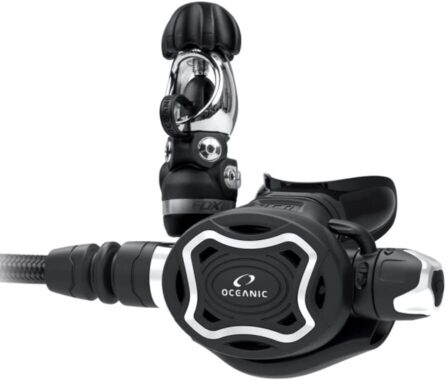
Although it’s only mid-price range, the Oceanic Zeo FDXI has many qualities of an upper end diving regulator. There is some serious value for money to be had here and for that reason, it’s our favourite all-rounder!
It is exceptionally light, weighing only 0.9kg – just ten grams more than the lightest regulator, the Atomic Aquatics T3. Furthermore, the Oceanic Zeo FDXI is compact, resistant and highly ergonomic in it’s overall design.
The cold forged, over-balanced diaphragm FDXI first stage is environmentally sealed which means it prevents dirt or grit getting inside. Furthermore, it’s rated for use in water as cold as four degrees celcius, whilst an optional cold water kit is available for extreme conditions.
A chrome plated brass metal valve results in superb air delivery, whilst improving cold water performance. This also helps to recirculate moisture from exhalation – reducing the chance of a dry mouth. It is possible to adjust cracking effort at any time in a dive by turning a large knob, which allows for a wide range of control over airflow.
The Oceanic Zeo FDXI is one of the few models to be “overbalanced”, which basically means it allows even easier breathing, when diving at depth and/or low on air. (Find out more about diving regulator terms like “balanced’ and “overbalanced”, by checking out the scuba regulator terminology section below!)
The second stage is very light and there is no feeling of weight in your jaw whilst the mouth piece tabs are also extremely soft and the flexi hose is noticeable when you turn your head. Plus, the minimalist design of the second stage allows you to easily get your face right up close to viewfinders and things of interest.
Without a doubt, you’ll not only know where your money is going when you lay it down on the Oceanic Zeo FDXI; you may even be surprised it was not more expensive with it’s stellar design, excellent features and consistent reliability. This is one of the very best all round travel regulators and it comes at an incredible price.
PROS:
- Available in DIN or Yoke
- Swivel ball on second stage improves comfort
- Lightweight and ergonomic design
- Overbalanced for maximum ease of breathing
- Cold water regulator certified to four degrees celcius
- Extremely Durable
CONS:
- A little expensive
4) Top Seller: Scubapro MK21 / S560
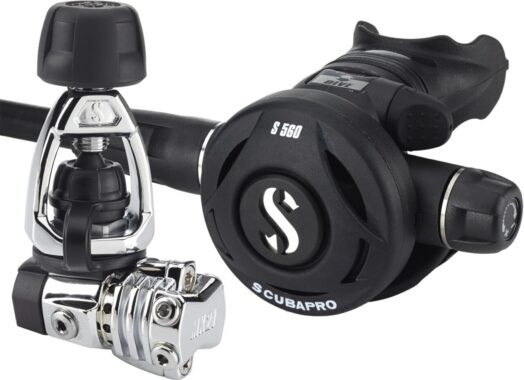
Another mid-pricer, the Scubapro MK21 was highly acclaimed when first produced several years ago and has become very popular among scuba divers all around the world.
It’s first stage is designed to be exceptionally lightweight whilst it’s polished chrome plated marine brass body is both small and compact. External fins help to optimise freezing resistance and these, combined with environmental sealing mean that the MK21 can be used for cold water diving.
Two high pressure and four low pressure ports allow for several setup configurations. The MK21 features a balanced design meaning users will find it easier to breath through at depth and when low on air than an unbalanced model, though not as well as if it was overbalanced like the Atomic Aquatics T3 or Oceanic ZEO.
The air balanced s560 second stage is designed to be lightweight and comfortable. It features a lightweight techno-polymer casing and comes with a range of nice user controls including pre-dive and venturi. It’s also comfortable to have in your mouth and feels weightless!
The total weight of the Scubapro MK21 regulator is 1.1kg / 2.5lbs. This makes it a little heavier than the other travel regulators, we’ve reviewed so far. As mentioned, it is balanced – which is a sought after feature in regulators, although it’d be nicer if it was overbalanced.
It’s also worth pointing out that the second stage of this make of regulator does feel a bit large and clunky – at least a little more so than most travel regulators and certainly a lot more than say the Hollis DC7.
All things said, however this is a good regulator – it’s reliable, affordable, fairly lightweight and compact and the balanced system ensures easy breathing. It’s also nice that it can be used in cold water! This regulators features combined and it’s high reputation have resulted in a lot of sales for the Scubapro MK21 .
That said, we do feel that in recent years several better options for the same price margin; namely the Oceanic ZEO and Hollis DC7 regulators.
PROS:
- Balanced
- Only weighs 1.1kg
- Suitable for cold water diving
- Affordable
- Features pre-dive and venturi controls
- Strong reputation and commited fan base
CONS:
- Not overbalanced
- A bit heavier than other travel regulators
- Second stage feels a little clunky
- Not as recently made as other options
5) Alternative Option: Hollis 500SE / DC7
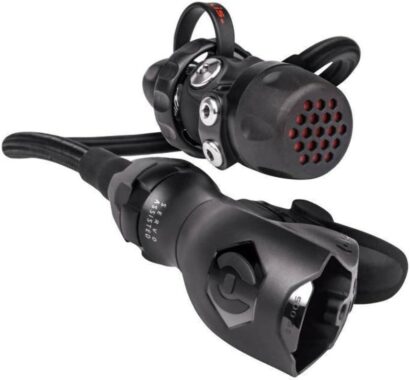
The Hollis DC7/ 500SE combo will definitely make you stand out from the crowd! The second stage is a side exhaust regulator, which have seen a revival of popularity in recent years. The main advantage of side exhaust regulators is that exhaled gas bubbles are sent toward the rear and away from your face, to prevent your vision being obscured.
Also, from a travel perspective, the shape of this second stag side exhaust regulator is longer and thinner than that of a normal regulator; which for some people will make it easier to pack; depending on their packing style and baggage. This ergonomic design is either going to really appeal or strongly put off some people. It all comes down to personal preference!
With a weight of 1.1kg (2.4lbs), the Hollis 500sE / DC7 is lightweight but still about 0.2 – 0.3kg heavier than most other travel regulators. Honestly, you probably won’t notice this weight difference much, but you will notice it’s overall shape of the second stage making it easier (or more challenging) to pack.
The first stage features an over balanced diaphragm, which provides progressively greater air delivery pressure at depth and gas density increases, making it great for deep dives or tech diving. It is environmentally sealed to prevent internal corrosion, containments and icing of the first stage.
Furthermore this regulator is designed to pass rigorous cold water regulations, making it suitable for any diving conditions.
Coming in DIN format, the first stage has two high pressure and four low pressure ports , is compatible with up to 40% EAN and is connected to the second stage by a lightweight and flexible maxweight hose. Fixed hose mounting is ideal for both backmount and sidemount configuration.
Hollis pride the 500se on it’s pneumatically balanced servo valve system whilst the mouthpiece has a patented design to improve comfort and reduce jaw fatigue. The second stage can be easily disassembled without the use of tools and underwater if necessary.
You can purge this regulator by pressing a small honeycomb pad at at the rear of the exhaust port. Some users have reported that this pad can be a little stiff to operate, but it’s easy to get used to!
Ultimately, the Hollis 500SE/DC7 is a very well made travel regulator that is both affordable and has many great features. It’s side exhaust secondary stage configuration is likely to be either a making or a breaking point, depending on what you’re into. The choice is yours!
PROS:
- Side Exhaust Primary Stage – may make packing easier
- Overbalanced
- Suitable for cold water diving
- Affordable – Great Value
- Mouth piece has panted design to improve comfort and reduce jaw fatigue
- Second stage can easily be disassembled
- Fixed hose mounting is ideal for both backmount and sidemount configuration
CONS:
- Side exhaust will appeal to some and not others
- A little heavier than most other travel regulators
- Purge pad is a little stiff
Diving Regulator Terminology:
- Unbalanced- Use piston and diaphragm designs. A little harder to breathe through especially as your air tank diminishes and when you descend and pressure increases.
- Balanced – Nowadays, mid range scuba regulators usually have this feature. Balanced regulators compensate for depth and decreasing air tank pressure by equalising. the air pressure on both sides of the valve. This allows you to breathe more easily.
- Over-balanced – A fairly recent feature that is generally only seen in high end diving regulators. It accomplishes what the balanced feature does (making breathing easier), only better. A balanced regulator doesn’t increase the pressure of the air it sends to the second stage to exactly match that of the surrounding water as a normal balanced first stage would do. Instead it delivers air at a slightly higher pressure than that of the surrounding water. The result – insanely easy breathing!
- First Stage – The metal end of the cylinder you attach to the air tank – it’s where the two regulators, dive gauge and pressure hose all come together. All mechanisms which lower the air pressure to an intermediate pressure are housed here.
- Second Stage – This is the part of the setup which the diver puts in their mouth and breathes from. It’s attached to the first stage by the LP hose.
- Environmentally Sealed – This means the first stage is environmentally sealed, which means that water is kept out preventing contamination in dirty water and icing in cold water. An environmentally sealed regulator is usually suitable for diving in cold water and such frequent maintenance.
- Yoke / DIN – The two types of coupling used to attach a regulators first stage to the tank. Yoke fittings are clamped type mountings and more common whilst DIN fittings are threaded valves that you screw into the tank. Most scuba regulator manufacturers offer conversion kits that allow you to change the fitting type ,so don’t get too hung up on this one!
- Pre Dive / Venturi System Settings – A “dive/pre dive” switch or knob on a regulator allows one to alter the airflow inside it, making breathing easier or more difficult via the venturi effect (which involves fast moving air molecules creating a vacuum).
For more information on scuba diving regulator types and terminology you can check out these other pages: Scuba Octopus Setup and Types of Diving Regulators.
Diving Squad Debriefing
Diving Squad! At ease, You’ve just finished the briefing for the best travel regulators available on the scuba divers market right now. Mission accomplished! Now go forth and craft your ultimate scuba gear arsenal. And do remember, we also have a a main page on Scuba Diving Regulators, with reviews of all the different types. Diving Squad dismissed!
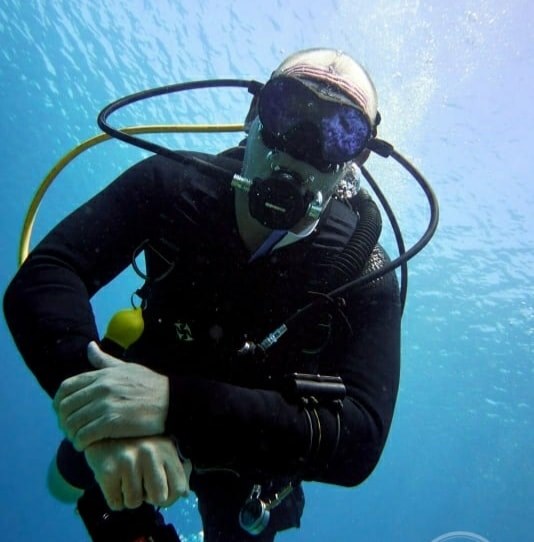
Support the Squad!
We are part of the Amazon Services LLC Associate Program. If you make a purchase on amazon after clicking a link on Diving Squad, we earn a small commission fee, at no extra cost to yourself.
We are also part of several other affiliate programs so if you click on a Diving Squad affiliate link that results in you booking a liveaboard, booking accommodation, purchasing insurance or buying a product somewhere else, once more we make a small commission, without it costing you a cent extra. Thanks!
Written by:
Alex
